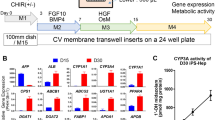Abstract
We show that mechanical separation of adherent rat primary hepatocytes after the monolayer-forming stage causes the induction of the oxidative stress genes HO-1 (haem oxygenase) and MnSOD (manganese superoxide dismutase). The procedures for enzymatically breaking up liver tissue structure and isolating hepatocytes do not cause HO-1 and MnSOD activation. Only after a 3-h incubation, during which hepatocytes form a monolayer on culture dishes, does the hydrodynamic shearing away of necrotic cells sticking to the monolayer surface activate these two genes. Analysis of this injury-response pathway shows that oxidative stress and mitochondrial dysfunction play a role, as activation can be repressed by antioxidants and by respiratory inhibitors. Recovery of the cells takes a further 24-h incubation during which HO-1 and MnSOD expression returns to basal levels.
Similar content being viewed by others
Author information
Authors and Affiliations
Additional information
Received: 23 June 1998 / Accepted: 14 August 1998
Rights and permissions
About this article
Cite this article
Pillar, T., Seitz, H. Oxidative stress response induced in rat primary hepatocyte monolayers by mechanical removal of adherent cells. Cell Tissue Res 295, 363–367 (1999). https://doi.org/10.1007/s004410051243
Issue Date:
DOI: https://doi.org/10.1007/s004410051243




